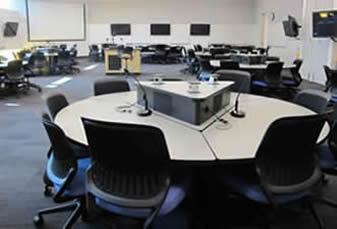 NSF Grant Supports Active Learning NSF Grant Supports Active Learning
NMU has received a $160,000 grant from the National Science Foundation to promote active learning in the STEM disciplines of science, technology, engineering and math. The funding covers training for six faculty "catalysts" to redesign at least one of their own courses and serve as models for teaching colleagues within and beyond their departments. It will also enable NMU to create a student-centered, technology-rich classroom to support active learning (a model at the University of Minnesota is pictured).
The project will assess the effectiveness of technologies used and the extent to which faculty members embraced the pedagogy in order to develop "best practices" recommendations.
Jill Leonard, Jackie Bird (Biology), Matt Smock (Instructional Design and Technology) and J.D. Phillips (Mathematics and Computer Science) are the principal investigators. Leonard said she was trained in active and inquiry-based learning through the National Science Foundation’s FIRST II program, or Faculty Institutes for Reforming Science Teaching, and has used it in her NMU classes.
 “A lot of people are trained in active learning and may try it for a while, but they find it hard to implement in their classrooms, so the space matters,” said Leonard. “On the other hand, you can build the best space, but it won’t do much good if instructors don’t know how to use it effectively, so training matters. The NSF would not fund one or the other, so we submitted a request that includes both an active learning classroom and professional development. “A lot of people are trained in active learning and may try it for a while, but they find it hard to implement in their classrooms, so the space matters,” said Leonard. “On the other hand, you can build the best space, but it won’t do much good if instructors don’t know how to use it effectively, so training matters. The NSF would not fund one or the other, so we submitted a request that includes both an active learning classroom and professional development.
“The focal faculty—one from each STEM area—will receive release time to redesign and deliver their courses. They will also give seminars in their departments for colleagues who might be interested. It should be fun and informative to see how well the catalysts adopt active learning and how that translates to other people. For students, it’s incredibly engaging and involves them more because they have to actively participate. Typically STEM learning in lecture courses is more passive and memory-driven and less active.”
Room 108 in the Learning Resources Center will be renovated to include the following: circular tables, each with its own LCD panel to project content from any laptop computer; a centrally located instructor's station; two ceiling-mounted projectors with a screen at each end of the space; whiteboards; and digital visualizers that can capture photos, videos, microscopic slides and demonstrations/manipulations and project them on the LCD screens. The room’s location across from Instructional Design and Technology will make it convenient to address any issues that surface with the equipment.
 “Some institutions have put active learning classrooms into practice already and done research on what works and what doesn’t,” said Smock. “We didn’t want to re-create the wheel. Our setup will be similar to one I saw in a presentation by the University of Minnesota, but it will incorporate unique aspects of NMU. For example, because we’re a laptop university, all students in the class should be able to hook up their computers. The room will be pretty souped-up as a starting point, but not all gadgets are created equal in helping students learn, so we’ll see what’s used most often and most effectively.” “Some institutions have put active learning classrooms into practice already and done research on what works and what doesn’t,” said Smock. “We didn’t want to re-create the wheel. Our setup will be similar to one I saw in a presentation by the University of Minnesota, but it will incorporate unique aspects of NMU. For example, because we’re a laptop university, all students in the class should be able to hook up their computers. The room will be pretty souped-up as a starting point, but not all gadgets are created equal in helping students learn, so we’ll see what’s used most often and most effectively.”
Training is scheduled to begin this fall and the active learning classroom will be up and running for the winter semester. If the faculty response and other outcomes prove positive, Leonard and Smock agree that the active learning classroom could be useful in other disciplines and factor into planning for the Jamrich Hall renovation. |





